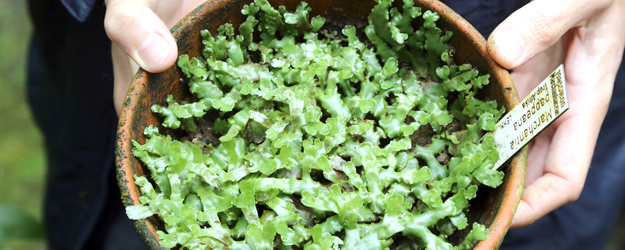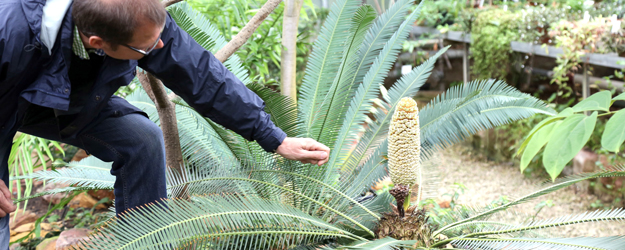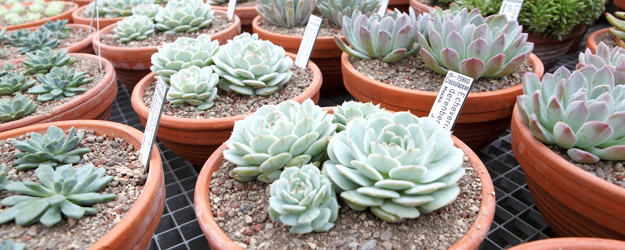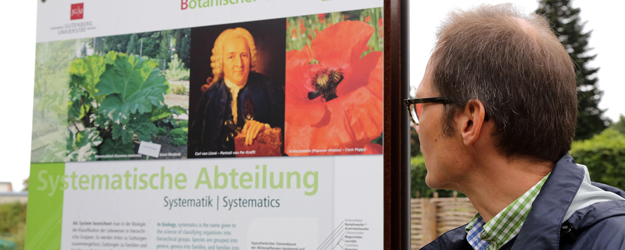7 October 2013
There is hardly any other place at Johannes Gutenberg University Mainz (JGU) that is as inviting to relax or take a stroll as the Botanic Garden. However, it is much more than simply a recreational facility. The garden is a place of research and teaching while it also provides a storehouse of rare plants, which is the largest of all the collections present on campus.
We start our tour below ground. It is cold and damp here. The late summer sun shines through the skylights. We are in the Earth House of the Botanic Garden, which is a small basement room filled with orchids. Visitors need to duck their heads when they enter. The ventilation growls away in the background. Dr. Ralf Omlor stands in front of a row of quite ordinary flower pots.
"This is probably what one of the first terrestrial plants looked like," says the curator of the Botanic Garden and then picks up one of the pots. There is a dark, inconspicuous green something that seems to press itself into the soil. "It was 470 million years ago that plants first emerged from water to conquer the land." Those first land plants were mosses like this one. The little white sign reads Marchantia pappeana. "This is a liverwort," explains Omlor. "It comes from tropical Africa."
Tiny pioneers of the plant kingdom
A large section of the Botanic Garden, which is part of the JGU Institute for Special Botany, is accessible to the public. However, the Garden’s Earth House is not. The basement is for plants that need light but are unable to withstand high temperatures. The liverwort is not exactly an eye catcher; it does not have any flowers or prettily frilled leaves. But attractiveness is not necessarily the most important factor at the Botanic Garden. "It is our aim to collect a cross-section of plants that represent the entire plant world." And a pioneer plant like this is important when it comes to achieving that objective.
The garden is by far the largest and best known collection at Mainz University, even though most people do not think of the 9-hectare grounds as a collection. Collections for most people take the form of assemblages of books or sculptures, specimens from foreign cultures, or works of art.
"In fact, the garden was primarily intended to act as a collection when it was first established," Omlor goes on to tell. The garden was originally planted between 1946 and 1955 under the supervision of Professor Wilhelm Troll. The idea was that the garden should provide plants for university teaching and research, and this is something it still does to this day. However, the garden now has a lot more to offer.
Omlor climbs a narrow staircase that leads to one of the many greenhouses. Some of the gardeners shortly glance up from their work. The Botanic Garden employs and trains some 30 gardeners. The 9,000 different plants need many capable green fingers to look after them.
The houseleek as the subject of phylogenetic research
In the greenhouse, Omlor moves forward in time by about 400 million years. He points out a plant that looks like an over-sized pine cone into which someone has stuck a number of palm fronds. "This is an ancestor of flowering plants." Encephalartos villosus is the name on the little white sign. The plant is a member of the cycad family.
Then he goes out to where there are hundreds of different examples of houseleeks lined up in pots. "The Botanic Garden has permanent collections along with special temporary collections like this one." Houseleeks have been collected from throughout Europe over the years and now the goal is to clarify the interrelationships between the individual species. "This is probably the largest collection of houseleeks in the world," points out Omlor. "But what are we going to do with them when the project is completed?" This is a recurring problem. "We can't just keep everything." There is a limit to what you can retain on an area measuring 9 hectares.
The custodian points out plants everywhere, even on the paths, where a small plant called prostrate spurge is growing. "You can't deliberately cultivate something like this. It just grows on its own." It originates from southern latitudes and has made its home here. The gardeners also keep an eye out for plants like this.
The ascendancy of the flowering plants
The scientific heart of the garden is the Systematic Department, a colorful carpet of plant beds. The flowering plants are carefully arranged by class, genus, and family. Grasses are here along with trees and much more. "Of the 300,000 identified plants on our planet, 250,000 are flowering plants," says Omlor. In the center of the arrangement are water lilies floating in a pond. "They are among the very first flowering plants."
The Botanic Garden at Mainz University has long been far more than a facility for research and teaching. It has become a recreational destination. Children and young people go in and out of its Green School while festivities and tours regularly lure visitors to the grounds. This aspect has become ever more important over the past few decades. The current director, Professor Joachim W. Kadereit, first opened many of the greenhouses to amateur gardeners in the early 1990s.
The Botanic Garden also helps conserve rare plant systems. Omlor brings us to one: A remnant of the former Ice Age steppe landscape, the area lying between the Mainz districts of Mombach and Gonsenheim is unique in Europe – well almost. A small-scale replica of it has been created in the Botanic Garden.
"If you want to experience the huge variety of plants in this environment, you just need to come here," says the custodian. "Biological diversity is not just something you find in tropical regions. We have it on our very own doorstep." The rare Onosma arenaria, Bassia laniflora, and Helianthemum nummularium thrive in the sandy soil here.
Plant exchange with partner gardens
At the end of the tour we enter a room filled with drawers. "This is our backup," explains Omlor. Seeds from almost all the plants in the Botanic Garden are stored here in brown envelopes. "We send a catalog of our holdings to about 500 partner gardens every year. They pay us back with their seed indexes, so that we can trade free of charge. We thus have access to about a third of all the plant species in the world."




